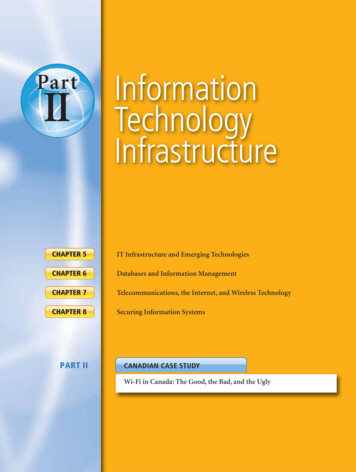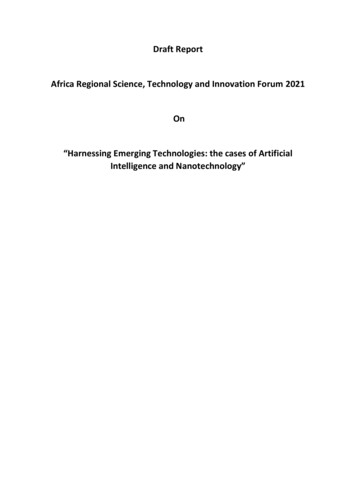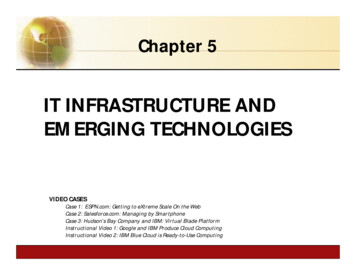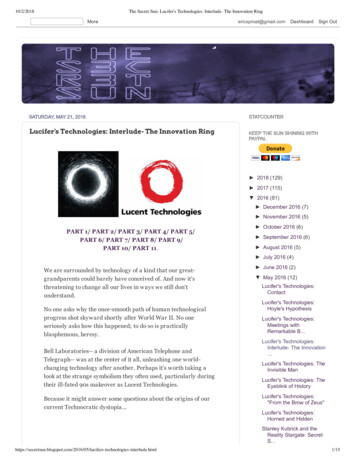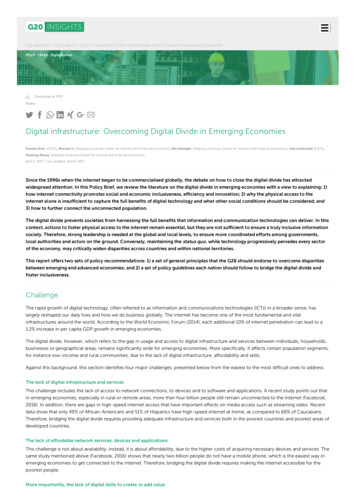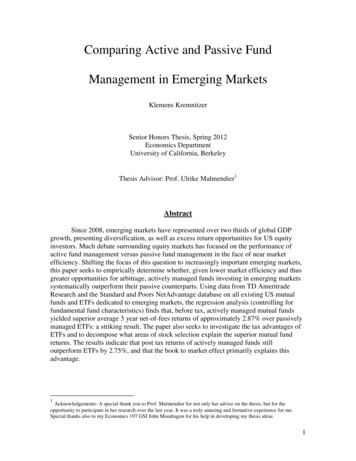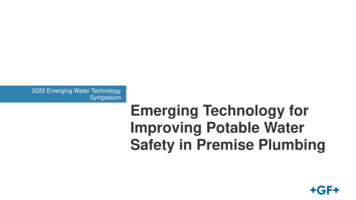
Transcription
Management Information SystemsMANAGING THE DIGITAL FIRM, 12TH EDITIONChapter 5IT INFRASTRUCTURE ANDEMERGING TECHNOLOGIESVIDEO CASESCase 1: Google and IBM Produce Cloud ComputingCase 2: IBM Blue Cloud is Ready-to-Use ComputingCase 3: What the Hell is Cloud Computing?Case 4: What is AJAX and How Does it Work?Case 5: Yahoo's FireEagle Geolocation Service
Management Information SystemsCHAPTER 5: IT INFRASTRUCTURE AND EMERGING TECHNOLOGIESLearning Objectives Define IT infrastructure and describe itscomponents. Identify and describe the stages and technologydrivers of IT infrastructure evolution. Assess contemporary computer hardware platformtrends. Assess contemporary software platform trends. Evaluate the challenges of managing ITinfrastructure and management solutions.2 Prentice Hall 2011
Management Information SystemsCHAPTER 5: IT INFRASTRUCTURE AND EMERGING TECHNOLOGIESBART Speeds Up with a New IT Infrastructure Problem: Aging systems no longer able to provideinformation rapidly enough for timely decisions; toounreliable for 24/7 operations Solutions: Replaced and upgraded hardware and softwareand used leading-edge technology– Grid computing– Virtualization– Blade servers Demonstrates IT’s role in using resources more efficiently;reducing computing energy usage, modernizing services3 Prentice Hall 2011
Management Information SystemsCHAPTER 5: IT INFRASTRUCTURE AND EMERGING TECHNOLOGIESIT Infrastructure IT infrastructure:– Set of physical devices and software required tooperate enterprise– Set of firmwide services including: Computing platforms providing computing servicesTelecommunications servicesData management servicesApplication software servicesPhysical facilities management servicesIT management, standards, education, research and developmentservices– “Service platform” perspective more accurate viewof value of investments4 Prentice Hall 2011
Management Information SystemsCHAPTER 5: IT INFRASTRUCTURE AND EMERGING TECHNOLOGIESIT InfrastructureCONNECTION BETWEEN THE FIRM, IT INFRASTRUCTURE, AND BUSINESS CAPABILITIESFIGURE 5-15The services a firm is capable of providing to its customers, suppliers, and employees are a direct functionof its IT infrastructure. Ideally, this infrastructure should support the firm’s business and informationsystems strategy. New information technologies have a powerful impact on business and IT strategies, aswell as the services that can be provided to customers. Prentice Hall 2011
Management Information SystemsCHAPTER 5: IT INFRASTRUCTURE AND EMERGING TECHNOLOGIESIT Infrastructure Evolution of IT infrastructure– General-purpose mainframe & minicomputer era: 1959 topresent 1958 IBM first mainframes introduced 1965 Less expensive DEC minicomputers introduced– Personal computer era: 1981 to present 1981 Introduction of IBM PC Proliferation in 80s, 90s resulted in growth of personal software– Client/server era: 1983 to present Desktop clients networked to servers, with processing work splitbetween clients and servers Network may be two-tiered or multitiered (N-tiered) Various types of servers (network, application, Web)6 Prentice Hall 2011
Management Information SystemsCHAPTER 5: IT INFRASTRUCTURE AND EMERGING TECHNOLOGIESIT InfrastructureSTAGES IN ITINFRASTRUCTUREEVOLUTIONIllustrated here are the typicalcomputing configurationscharacterizing each of the fiveeras of IT infrastructureevolution.FIGURE 5-27 Prentice Hall 2011
Management Information SystemsCHAPTER 5: IT INFRASTRUCTURE AND EMERGING TECHNOLOGIESIT Infrastructure Evolution of IT infrastructure (cont.)– Enterprise computing era: 1992 to present Move toward integrating disparate networks,applications using Internet standards and enterpriseapplications– Cloud Computing: 2000 to present Refers to a model of computing where firms andindividuals obtain computing power and softwareapplications over the Internet or other network Fastest growing form of computing8 Prentice Hall 2011
Management Information SystemsCHAPTER 5: IT INFRASTRUCTURE AND EMERGING TECHNOLOGIESIT InfrastructureSTAGES IN ITINFRASTRUCTUREEVOLUTION (cont.)Illustrated here are the typicalcomputing configurationscharacterizing each of the fiveeras of IT infrastructureevolution.FIGURE 5-29 Prentice Hall 2011
Management Information SystemsCHAPTER 5: IT INFRASTRUCTURE AND EMERGING TECHNOLOGIESIT InfrastructureA MULTITIERED CLIENT/SERVER NETWORK (N-TIER)FIGURE 5-310In a multitiered client/server network, client requests for service are handled by different levels of servers. Prentice Hall 2011
Management Information SystemsCHAPTER 5: IT INFRASTRUCTURE AND EMERGING TECHNOLOGIESIT Infrastructure Technology drivers of infrastructure evolution– Moore’s law and microprocessing power Computing power doubles every 18 months Nanotechnology:– Shrinks size of transistors to size comparable to sizeof a virus– Law of Mass Digital Storage The amount of data being stored each yeardoubles11 Prentice Hall 2011
Management Information SystemsCHAPTER 5: IT INFRASTRUCTURE AND EMERGING TECHNOLOGIESIT InfrastructureMOORE’S LAW ANDMICROPROCESSORPERFORMANCEPacking over 2 billiontransistors into a tinymicroprocessor hasexponentially increasedprocessing power. Processingpower has increased to over500,000 MIPS (millions ofinstructions per second).FIGURE 5-412 Prentice Hall 2011
Management Information SystemsCHAPTER 5: IT INFRASTRUCTURE AND EMERGING TECHNOLOGIESIT InfrastructureFALLING COSTOF CHIPSPacking more transistorsinto less space hasdriven down transistorcost dramatically as wellas the cost of theproducts in which theyare used.FIGURE 5-513 Prentice Hall 2011
Management Information SystemsCHAPTER 5: IT INFRASTRUCTURE AND EMERGING TECHNOLOGIESIT InfrastructureEXAMPLES OFNANOTUBESNanotubes are tiny tubesabout 10,000 times thinnerthan a human hair. Theyconsist of rolled up sheets ofcarbon hexagons and havepotential uses as minusculewires or in ultrasmall electronicdevices and are very powerfulconductors of electricalcurrent.FIGURE 5-614 Prentice Hall 2011
Management Information SystemsCHAPTER 5: IT INFRASTRUCTURE AND EMERGING TECHNOLOGIESIT InfrastructureTHE COST OFSTORING DATADECLINESEXPONENTIALLY1950–2010Since the first magnetic storagedevice was used in 1955, thecost of storing a kilobyte ofdata has fallen exponentially,doubling the amount of digitalstorage for each dollarexpended every 15 months, onaverage.FIGURE 5-715 Prentice Hall 2011
Management Information SystemsCHAPTER 5: IT INFRASTRUCTURE AND EMERGING TECHNOLOGIESIT Infrastructure Technology drivers of infrastructure evolution(cont.)– Metcalfe’s Law and network economics Value or power of a network growsexponentially as a function of the number ofnetwork members As network members increase, more peoplewant to use it (demand for network accessincreases)16 Prentice Hall 2011
Management Information SystemsCHAPTER 5: IT INFRASTRUCTURE AND EMERGING TECHNOLOGIESIT Infrastructure Technology drivers of infrastructure evolution(cont.)– Declining communication costs and the Internet An estimated 1.5 billion people worldwide haveInternet access As communication costs fall toward a very smallnumber and approach 0, utilization ofcommunication and computing facilitiesexplodes17 Prentice Hall 2011
Management Information SystemsCHAPTER 5: IT INFRASTRUCTURE AND EMERGING TECHNOLOGIESIT InfrastructureEXPONENTIAL DECLINES IN INTERNET COMMUNICATIONS COSTSFIGURE 5-818One reason for the growth in the Internet population is the rapid decline in Internet connection and overallcommunication costs. The cost per kilobit of Internet access has fallen exponentially since 1995. Digitalsubscriber line (DSL) and cable modems now deliver a kilobit of communication for a retail price of around2 cents. Prentice Hall 2011
Management Information SystemsCHAPTER 5: IT INFRASTRUCTURE AND EMERGING TECHNOLOGIESIT Infrastructure Technology drivers of infrastructure evolution(cont.)– Standards and network effects Technology standards:– Specifications that establish the compatibility ofproducts and the ability to communicate in anetwork– Unleash powerful economies of scale and result inprice declines as manufacturers focus on theproducts built to a single standard19 Prentice Hall 2011
Management Information SystemsCHAPTER 5: IT INFRASTRUCTURE AND EMERGING TECHNOLOGIESInfrastructure Components IT Infrastructure has 7 main components1.2.3.4.5.6.7.20Computer hardware platformsOperating system platformsEnterprise software applicationsData management and storageNetworking/telecommunications platformsInternet platformsConsulting system integration services Prentice Hall 2011
Management Information SystemsCHAPTER 5: IT INFRASTRUCTURE AND EMERGING TECHNOLOGIESIT InfrastructureTHE ITINFRASTRUCTUREECOSYSTEMThere are seven majorcomponents that must becoordinated to provide the firmwith a coherent ITinfrastructure. Listed here aremajor technologies andsuppliers for each component.FIGURE 5-921 Prentice Hall 2011
Management Information SystemsCHAPTER 5: IT INFRASTRUCTURE AND EMERGING TECHNOLOGIESInfrastructure Components Computer hardware platforms– Client machines Desktop PCs, mobile devices – PDAs, laptops– Servers Blade servers: ultrathin computers stored in racks– Mainframes: IBM mainframe equivalent to thousands of bladeservers– Top chip producers: AMD, Intel, IBM– Top firms: IBM, HP, Dell, Sun Microsystems22 Prentice Hall 2011
Management Information SystemsCHAPTER 5: IT INFRASTRUCTURE AND EMERGING TECHNOLOGIESInfrastructure Components Operating system platforms– Operating systems Server level: 75% run Windows; 25% run Unix or Linux Client level:– 90% run Microsoft Windows (XP, 2000, CE, etc.)– Handheld device OS’s (Android, iPhone OS)– Cloud computing OS’s (Google’s Chrome OS) Enterprise software applications– Enterprise application providers: SAP and Oracle– Middleware providers: BEA23 Prentice Hall 2011
Management Information SystemsCHAPTER 5: IT INFRASTRUCTURE AND EMERGING TECHNOLOGIESInfrastructure ComponentsNEW TO THE TOUCHRead the Interactive Session and discuss the following questions What problems does multitouch technology solve? What are the advantages and disadvantages of a multitouchinterface? How useful is it? Explain. Describe three business applications that would benefitfrom a multitouch interface. What management, organization, and technology issuesmust be addressed if you or your business was consideringsystems and computers with multitouch interfaces?24 Prentice Hall 2011
Management Information SystemsCHAPTER 5: IT INFRASTRUCTURE AND EMERGING TECHNOLOGIESInfrastructure Components Data management and storage– Database software: IBM (DB2), Oracle, Microsoft (SQL Server),Sybase (Adaptive Server Enterprise), MySQL– Physical data storage: EMC Corp (large-scale systems), Seagate,Maxtor, Western Digital– Storage area networks (SANs): Connect multiple storage devices on dedicatednetwork25 Prentice Hall 2011
Management Information SystemsCHAPTER 5: IT INFRASTRUCTURE AND EMERGING TECHNOLOGIESInfrastructure Components Networking/telecommunications platforms– Telecommunication services Telecommunications, cable, telephonecompany charges for voice lines and Internetaccess AT&T, Verizon– Network operating systems: Windows Server, Novell, Linux, Unix– Network hardware providers: Cisco, Alcatel-Lucent, Nortel, Juniper Networks26 Prentice Hall 2011
Management Information SystemsCHAPTER 5: IT INFRASTRUCTURE AND EMERGING TECHNOLOGIESInfrastructure Components Internet platforms– Hardware, software, management services tosupport company Web sites, (including Webhosting services) intranets, extranets– Internet hardware server market: Dell,HP/Compaq, IBM– Web development tools/suites: Microsoft(FrontPage, .NET) IBM (WebSphere) Sun (Java),independent software developers: Adobe,RealMedia27 Prentice Hall 2011
Management Information SystemsCHAPTER 5: IT INFRASTRUCTURE AND EMERGING TECHNOLOGIESInfrastructure Components Consulting and system integration services– Even large firms do not have resources for a fullrange of support for new, complex infrastructure– Software integration: ensuring newinfrastructure works with legacy systems– Legacy systems: older TPS created formainframes that would be too costly to replaceor redesign– Accenture, IBM Global Services, EDS, Infosys,Wipro28 Prentice Hall 2011
Management Information SystemsCHAPTER 5: IT INFRASTRUCTURE AND EMERGING TECHNOLOGIESContemporary Hardware Platform Trends The emerging mobile digital platform– Cell phones, smartphones (BlackBerry, iPhone) Have assumed data transmission, Web surfing,e-mail and IM duties– Netbooks: Small, low-cost lightweight notebooksoptimized for wireless communication and corecomputing tasks– Tablets (iPad)– Networked e-readers (Kindle)29 Prentice Hall 2011
Management Information SystemsCHAPTER 5: IT INFRASTRUCTURE AND EMERGING TECHNOLOGIESContemporary Hardware Platform Trends Grid computing– Connects geographically remote computers into asingle network to combine processing power andcreate virtual supercomputer– Provides cost savings, speed, agility Virtualization– Allows single physical resource to act as multipleresources (i.e., run multiple instances of OS)– Reduces hardware and power expenditures– Facilitates hardware centralization30 Prentice Hall 2011
Management Information SystemsCHAPTER 5: IT INFRASTRUCTURE AND EMERGING TECHNOLOGIESContemporary Hardware Platform Trends Cloud computing– On-demand (utility) computing services obtainedover network Infrastructure as a service Platform as a service Software as a service– Cloud can be public or private– Allows companies to minimize IT investments– Drawbacks: Concerns of security, reliability31 Prentice Hall 2011
Management Information SystemsCHAPTER 5: IT INFRASTRUCTURE AND EMERGING TECHNOLOGIESContemporary Hardware Platform Trends Green computing– Practices and technologies for manufacturing, using,disposing of computing and networking hardware Autonomic computing– Industry-wide effort to develop systems that can configure,heal themselves when broken, and protect themselvesfrom outside intruders– Similar to self-updating antivirus software; Apple andMicrosoft both use automatic updates High performance, power-saving processors– Multi-core processors32 Prentice Hall 2011
Management Information SystemsCHAPTER 5: IT INFRASTRUCTURE AND EMERGING TECHNOLOGIESContemporary Hardware Platform TrendsIS GREEN COMPUTING GOOD FOR BUSINESS?Read the Interactive Session and discuss the following questions What business and social problems does datacenter power consumption cause? What solutions are available for these problems?Which are environment-friendly? What are the business benefits and costs of thesesolutions? Should all firms move toward green computing?Why or why not?33 Prentice Hall 2011
Management Information SystemsCHAPTER 5: IT INFRASTRUCTURE AND EMERGING TECHNOLOGIESContemporary Software Platform Trends Linux and open-source software– Open-source software: Produced by community ofprogrammers, free and modifiable by user– Linux: Open-source software OS Software for the Web– Java: Object-oriented programming language Operating system, processor-independent– Ajax Asynchronous JavaScript and XML Allows client and server to exchange small pieces ofdata without requiring the page to be reloaded34 Prentice Hall 2011
Management Information SystemsCHAPTER 5: IT INFRASTRUCTURE AND EMERGING TECHNOLOGIESContemporary Software Platform Trends Web Services– Software components that exchange information usingWeb standards and languages– XML: Extensible Markup Language More powerful and flexible than HTML Tagging allows computers to process data automatically– SOAP: Simple Object Access Protocol Rules for structuring messages enabling applications to pass dataand instructions– WSDL: Web Services Description Language Framework for describing Web service and capabilities– UDDI: Universal Description, Discovery, and Integration Directory for locating Web services35 Prentice Hall 2011
Management Information SystemsCHAPTER 5: IT INFRASTRUCTURE AND EMERGING TECHNOLOGIESContemporary Software Platform Trends SOA: Service-oriented architecture– Set of self-contained services that communicate witheach other to create a working software application– Software developers reuse these services in othercombinations to assemble other applications asneeded Example: an “invoice service” to serve whole firm forcalculating and sending printed invoices– Dollar Rent A Car Uses Web services to link online booking system withSouthwest Airlines’ Web site36 Prentice Hall 2011
Management Information SystemsCHAPTER 5: IT INFRASTRUCTURE AND EMERGING TECHNOLOGIESContemporary Software Platform TrendsHOW DOLLAR RENT A CAR USES WEB SERVICESFIGURE 5-1037Dollar Rent A Car uses Web services to provide a standard intermediate layer of software to “talk” to othercompanies’ information systems. Dollar Rent A Car can use this set of Web services to link to othercompanies’ information systems without having to build a separate link to each firm’s systems. Prentice Hall 2011
Management Information SystemsCHAPTER 5: IT INFRASTRUCTURE AND EMERGING TECHNOLOGIESContemporary Software Platform Trends Software outsourcing and cloud services– Three external sources for software:1. Software packages and enterprise software2. Software outsourcing (domestic or offshore)– Domestic:» Primarily for middleware, integration services, softwaresupport– Offshore:» Primarily for lower level maintenance, data entry, callcenters, although outsourcing for new-programdevelopment is increasing38 Prentice Hall 2011
Management Information SystemsCHAPTER 5: IT INFRASTRUCTURE AND EMERGING TECHNOLOGIESContemporary Software Platform Trends Three external sources for software (cont.)3. Cloud-based software services Software as a service (SaaS) Accessed with Web browser over Internet Ranges from free or low-cost services for individuals tobusiness and enterprise software Users pay on subscription or per-transaction E.g. Salesforce.com Service Level Agreements (SLAs): formal agreementwith service providers39 Prentice Hall 2011
Management Information SystemsCHAPTER 5: IT INFRASTRUCTURE AND EMERGING TECHNOLOGIESContemporary Software Platform TrendsCHANGINGSOURCES OF FIRMSOFTWAREIn 2010, U.S. firms will spendover 265 billion on software.About 40 percent of that ( 106billion) will originate outsidethe firm, either from enterprisesoftware vendors sellingfirmwide applications orindividual application serviceproviders leasing or sellingsoftware modules. Another 10percent ( 10 billion) will beprovided by SaaS vendors as anonline cloud-based service.FIGURE 5-1140 Prentice Hall 2011
Management Information SystemsCHAPTER 5: IT INFRASTRUCTURE AND EMERGING TECHNOLOGIESContemporary Software Platform Trends Software outsourcing and cloud services (cont.)– Mashups Combinations of two or more online applications, suchas combining mapping software (Google Maps) withlocal content– Apps Small pieces of software that run on the Internet, onyour computer, or on your cell phone– iPhone, BlackBerry, Android Generally delivered over the Internet41 Prentice Hall 2011
Management Information SystemsCHAPTER 5: IT INFRASTRUCTURE AND EMERGING TECHNOLOGIESManagement Issues Dealing with platform and infrastructure change– As firms shrink or grow, IT needs to be flexible andscalable– Scalability: Ability to expand to serve larger numbers of users– For mobile computing and cloud computing New policies and procedures for managing these newplatforms Contractual agreements with firms running clouds anddistributing software required42 Prentice Hall 2011
Management Information SystemsCHAPTER 5: IT INFRASTRUCTURE AND EMERGING TECHNOLOGIESManagement Issues Management and governance– Who controls IT infrastructure?– How should IT department be organized? Centralized– Central IT department makes decisions Decentralized– Business unit IT departments make own decisions– How are costs allocated betweendivisions, departments?43 Prentice Hall 2011
Management Information SystemsCHAPTER 5: IT INFRASTRUCTURE AND EMERGING TECHNOLOGIESManagement Issues Making wise infrastructure investments– Amount to spend on IT is complex question Rent vs. buy, outsourcing– Total cost of ownership (TCO) model Analyzes direct and indirect costs Hardware, software account for only about 20% of TCO Other costs: Installation, training, support,maintenance, infrastructure, downtime, space andenergy TCO can be reduced through use of cloud services,greater centralization and standardization of hardwareand software resources44 Prentice Hall 2011
Management Information SystemsCHAPTER 5: IT INFRASTRUCTURE AND EMERGING TECHNOLOGIESManagement Issues Competitive forces model for ITinfrastructure investment1.2.3.4.5.6.45Market demand for firm’s servicesFirm’s business strategyFirm’s IT strategy, infrastructure, and costInformation technology assessmentCompetitor firm servicesCompetitor firm IT infrastructure investments Prentice Hall 2011
Management Information SystemsCHAPTER 5: IT INFRASTRUCTURE AND EMERGING TECHNOLOGIESManagement IssuesCOMPETITIVE FORCES MODEL FOR IT INFRASTRUCTUREFIGURE 5-1246There are six factors you can use to answer the question, “How much should our firm spend on ITinfrastructure?” Prentice Hall 2011
Management Information SystemsCHAPTER 5: IT INFRASTRUCTURE AND EMERGING TECHNOLOGIESAll rights reserved. No part of this publication may be reproduced, storedin a retrieval system, or transmitted, in any form or by any means,electronic, mechanical, photocopying, recording, or otherwise, without theprior written permission of the publisher.Printed in the United States of America.Copyright 2011 Pearson Education, Inc.Publishing as Prentice Hall47 Prentice Hall 2011
CHAPTER 5: IT INFRASTRUCTURE AND EMERGING TECHNOLOGIES Problem: Aging systems no longer able to provide information rapidly enough for timely decisions; too unreliable for 24/7 operations Solutions: Replaced and upgraded hardware and software and used leading-edge technology -Grid computing -Virtualization -Blade servers


